That’s one way to create a new font.
“Fever and the Future of Feed Readers” →
Alex Payne:
The problem with abdicating your content consumption to other people, though, is other people. Perhaps it’s overestimating my ability to find interesting things to read, but I don’t trust my friends and the Internet at large to educate and entertain me. In the venn diagram of my interests and my friends’, there may be 80% overlap, but most of the content that I’m going to find deeply engaging is probably in the leftover 20% at the margins.
Also, Alex points out how Fever really only works if you subscribe to a lot of tech-related weblogs, as these are the ones that more commonly post links leading away from their site. Since I don’t read very many non-tech weblogs, Fever works great for me.
Between Twitter, Fever’s Hot List, and the small handful of my daily “must-reads”, I feel quite confident that I’m not missing the 20% of the most engaging content on the web. Also, I make sure to do my part and post a link when I do come across that 20%.
Like Merlin Mann said, “If linkbloggers wrote more, shovelbloggers thought more, and a-listers cited more, the web would get 15% more interesting overnight.”
Reader Setup: Tim Van Damme
Tim Van Damme is a Belgian webdesigner. By day he runs his little freelance company Made by Elephant, but by night he turns into his wild, alter ego called Maxvoltar. He is also a self-claimed celebrity tweeter with millions of followers.
Tim’s Setup:
What does your desk look like?

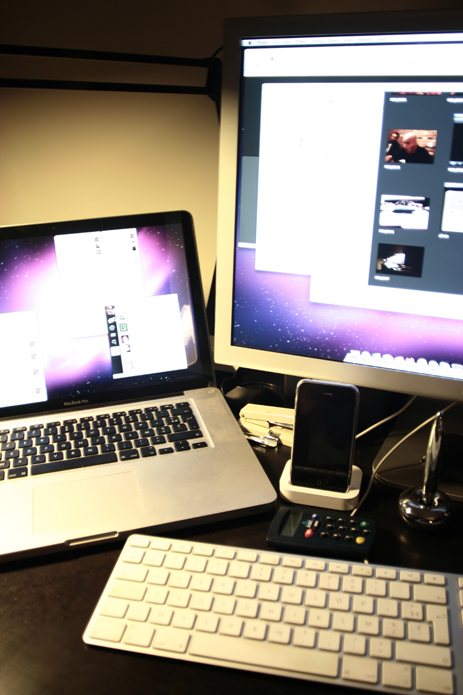
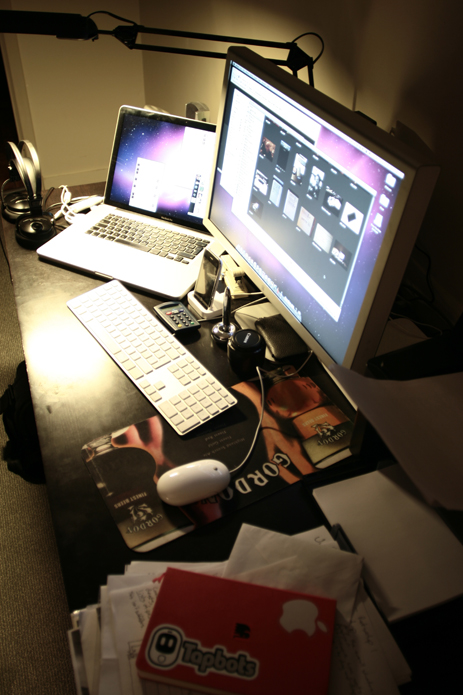
2. What is your current Mac setup?
I’m using a Unibody MacBook Pro 15.4″ (the one without SD, you know, that old piece of last-year’s hardware?). Besides that, I have a 23″ Apple Cinema Display, a 1Tb external Lacie drive (backup solution #1) and a 1Tb Time Capsule (wireless internet everywhere and backup solution #2).
3. Why are you using this setup?
Years ago I switched to using laptops, and wouldn’t want it any other way. About half the time I work from home (the setup in the pictures), and the other half I’m either at the office, or at a client. Anywhere I arrive, I just open my MacBook and start working where I left off. A laptop might not be the most powerful workstation around, but portability wins over power every time. I must admit having an external monitor is a big plus.
4. What software do you use on a daily basis, and for what do you use it?
Apps that are always running include Safari, Photoshop, Espresso, MailPlane, NetNewsWire, Tweetie, Skype, iChat, iTunes and LittleSnapper.
For a full list I’d like to point you to an interview Grace Smith did with me, exploring all the apps in my dock.
5. Do you own any other Mac gear?
A white MacBook which used to be mine, but is now being used by my girlfriend, an Apple TV, and an Airport Express that multiplies(?) the Wi-Fi at home.
Almost forgot: an iPhone 3GS.
6. Do you have any future upgrades planned?
I tend to buy a new iPhone each year, and a new MacBook Pro every 2 years. Maybe I’ll buy a second Cinema Display to use at home, and that 10″ NetBook Apple’s going to launch later this year.
More Sweet Setups
Tim’s setup is just one in a series of Sweet Mac Setups.
Coldplay’s Strawberry Swing Video →
Absolutely incredible sidewalk chalk and stop-motion music video for Coldplay’s song, Strawberry Swing.
“Notes” →
A For an iPhone, By an iPhone wallpaper of my notes and outline which I used to write the previous behind-the-scenes article of said website.
Building ‘For an iPhone, By an iPhone’
In May my old iPhone and I launched a new website. It’s a gallery of wallpapers and backgrounds for your iPhone, all taken with an iPhone camera. They’re for an iPhone, by an iPhone.
For the past two years, I haven’t used the iPhone’s camera very much. Mostly because my wife and I never think about taking pictures; we’re not photo-fanatics. But after hearing CameraBag from Joshua Blankenship and seeing his iPhonaroid set on Flickr, my interest in taking fun and artsy snapshots with my iPhone peaked.
Originally, I figured I would create a Flickr set like Josh did and upload the shots to there. But then, after coming across Greg Shmigel’s Just What I See website, the Flickr set seemed inadequate…
The name and concept of For an iPhone, By an iPhone materialized one evening while walking home from the general store with my wife eating popsicles. After a few days of designing and coding, along with a few more popsicles, the site was launched.
A Picture versus A Thousand Words
Building a simple, photo-based site was a nice change of pace. There are quite a few differences between an entirely image-based website and a text-based one, and it was nice to have new challenges to tackle.
At first the Home page design of For an iPhone, By an iPhone showed a cascading list of the five most recent pictures. I was thinking about the convenience of being able to see a handful of wallpapers all at once. Undoubtedly not everyone will like and use every single wallpaper and giving the ability for someone to quickly scan is a feature.
But having five full-sized images on every page (except for permalink pages) felt less like a feature and more like a competition between wallpapers. Which is why I decided to only display one image per page. And by placing the navigation just above the pictures while the title and the tags sit below, it is still easy to browse through each wallpaper, even though it is just one at a time.
However, in good conscience I couldn’t completely abandon the ability for someone to scan several images at once. Which is why the archives display multiple images per page. Not to mention, (a) browsing an image gallery by title is just about as productive as picking out new music by song title; and (b) if the archives displayed only one image per page, that would be the exact same as the way non-archives are displayed.
And getting the archives to display and work just right wasn’t as easy as it should have been. Displaying full-sized images within the archives, like the original Home page design, was overwhelming; the archives needed to be displayed as thumbnails. And even though there are a lot of photo-gallery plugins for WordPress I was unable to find a simple one that would do what I wanted. So I hacked my own system for displaying the archives.
When browsing the archives you are looking at the excerpt content wrapped in an <a> tag which links to the permalink of the wallpaper.
To get WordPress to display only one post per page unless it was an archive page I’m using Matt Read’s plugin, Custom Query String. The CQS plugin allowes me to set exactly how many posts (images) display in any type of archive pages. I set all archives to display fifteen posts per page, which shows five nice rows with three images each.
On shawnblanc.net categories are only discoverable from the sitemap, because it’s easy enough to link to past articles through a linked list post, or simply link to past articles organically within other articles. However, on For an iPhone, By an iPhone, tags are much more vital. When the only content of a post is the image and the title, you can’t interlink to your own posts in a photoblog unless you use tags.
The Problem With Permalinks and Pagination
Standard WordPress behavior is to display the latest post on the home page. But to view the previous posts, you don’t browse by permalink, you browse by page.
Which means that getting the latest picture to display on the Home page, but to have the “previous” link point to the pervious post’s actual permalink page rather than /page/2/ was a little bit tricky.
Because of the way For an iPhone, By an iPhone is set up (with only a single image per page) there is a problem with the default pagination from the Home page. Because you’re only viewing one image regardless if it’s a permalink or nor, you could easily get /page/2/ confused as the permalink for the image you see on page 2. But once a new image gets posted, what used to be on /page/2/ is now on /page/3/, etc., etc…
I wanted all browsing to be from one permalink to the next, so that at any given time you were precisely where you thought you were.
After some searching around, I discovered a simple line of code, that when placed above the loop, does the trick just perfectly:
<? php $wp_query->is_single = true; ?>
This line causes the Home page to act like the most recent post’s permalink page (yet without re-directing to the URL of the latest post). Thus, what would normally be the “Previous” link is now the title of and a link to the previous post.
Which means once you begin navigating from the home page you go from permalink to permalink, rather than page to page.
From Phone to Published
By the time a new wallpaper shows up on the website, a lot has happened with that image already.
It starts when I come across something or someone that warrants a picture. So I take one. Usually several, actually. The best of the shots is then processed through CameraBag or CameraKit [iTunes Link], and the next time I sync the iPhone, all the photos get dropped into iPhoto. They are then re-sized, cropped and watermarked via Photoshop, and saved as 320×480 pixel JPEGs.
The 320×480 images are then run through an Automator process that copies the original, renames it, and resizes it for the thumbnail used in the Archives.
I then upload all the full-size images and their repsective thumbnails with transmit, and then publish each one via MarsEdit.
It sounds like a lot for something so basic, but it’s not as tedious as it sounds.
When first developing the site, I thought about coding an automated process or using a plugin so that if I emailed my image directly to WordPress from my iPhone, then it would get automatically cropped, a thumbnail created, and the image published. But aside from finding a plugin that worked the way I wanted, a set-it-and-forget-it process felt too sterile — I prefer taking the time to hand-craft each image that gets posted.
An Aside Regarding Pageviews
Over the last seven weeks, For an iPhone has averaged a 53% bounce rate with about 4 pageviews per visit. Shawnblanc.net, on the other hand, has a 73% bounce rate and an average of 2 pageviews per visit.
The average new visitor to For an iPhone will browse twelve to fifteen pages on their first visit. The average new visitor to shawnblanc.net, if they don’t bounce right away, will browse perhaps only four or five.
The biggest contributing factor is that For an iPhone encourages pageviews due to its one-image-per-page layout. Since it’s natural and not forced, it isn’t a big deal to click through many pages each visit.
In contrast, shawnblanc.net offers a dozen posts right on the home page. And each article is usually a stand-alone piece, and that each link list item is intended to send the reader away from the site. (Since each website has its own definitions of success, and its own audience, it wouldn’t be fair to compare them against one another to define the achievement or failure of one or the other. But that doesn’t mean it’s not interesting to see the differences.)
For me, what defines the success of For an iPhone, By an iPhone isn’t that it would be full of jaw dropping iPhone photos and wallpapers. The site isn’t made up of individual images, but rather an overall collection of wallpapers all centered around and contributing to a simple and fun concept.
And it is the concept of For an iPhone, By an iPhone that makes it a success. That each image was taken with an iPhone camera, edited with iPhone software, and published for use on an iPhone screen.
“Pixels” →
This is one good-looking desktop wallpaper.
Thinking Space →
A very clever approach by The Economist for displaying creative people’s work space, the objects in that space, and why they’re there. There is some fascinating stuff here.
I particularly love Mercedes Bunz’s quote about her laptop:
The laptop is a part of me. Everywhere you travel, everywhere you go, it’s part of you. It’s a very strange object because a laptop is something where your private life and your friends meet your working life and stress. It’s all on one object now, and it’s the centre of my little world. I’m a writer, that’s what I do most. My ideas happen while I’m typing.
Reader Setup: Julian Schrader
Julian Schrader is the head of one-man-plus-partners web agency Schrader.io Design & Development based in Würzburg, Germany. Besides managing client projects and writing Ruby on Rails, XHTML and CSS, he’s currently studying for a Bachelor of Science in Business Informatics at the University of Würzburg.
Julian’s Setup:
What does your desk look like?
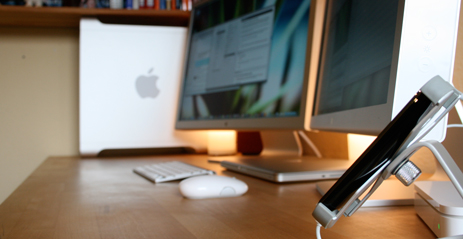
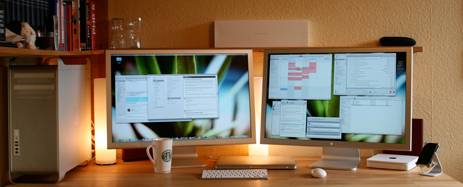
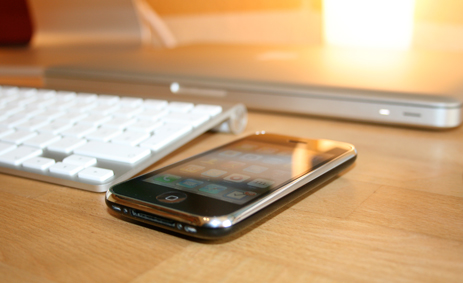
2. What is your current Mac setup?
A 2 × 3.0 GHz Quad-Core Intel Xeon (8-core) Mac Pro, with 6GB of RAM. Unfortunately still with the slow hard drive Apple Refurb put into it, so speed-wise there’s still a bottleneck to bust. To control this machine, I’m using a wireless Apple Keyboard and also a bluetooth Mighty Mouse, which unfortunately sometimes needs a special treatment.
Thanks to eBay, I recently added a second screen to my setup, totaling 2 × 30″ Apple Cinema HD Displays connected to the Mac Pro.
For my audio needs, I’m still using my old Sony stereo—its speakers hide behind the displays, iTunes DJ is shuffling through nearly all genres all day.
Unfortunately this setup isn’t worth anything on-the-go: When I’m working outside or at the university, I rely on my 15″ Unibody MacBook Pro (2.4 GHz Intel Core 2 Duo, 4GB of RAM) and, of course, on my 32GB iPhone 3GS.
3. Why are you using this setup?
Throughout the day, I’m switching between various setups depending on the task at hand. Whether that means “communication”, “coding” or “designing”, I always need to have multiple applications (and windows) open.
As Shawn put it: I’m “a dude with over 8 million pixels worth of screen real estate” (8.192.000 pixels to be precise), and I found large screens to be way more efficient than constantly switching between Leopard’s Spaces, as I did before.
And the MacBook Pro—well, easy: My iPhone can do a lot, but I need a real computer for lectures and the cafeteria, and it’s great to leave the desk for the garden every now and then.
4. What software do you use on a daily basis, and for what do you use it?
- Things combined with Things Touch on my iPhone — a killer task management setup for me. Everything goes into Things.
- Safari — browser of choice.
- DropBox — all my projects live in folders synced with DropBox. This ensures that all my data on the MacBook Pro is automagically up-to-date and everything I do at the university is reflected on my Mac Pro.
- iCal — All lectures and appointments go here. Thanks to MobileMe, this is always in sync on my machines and my iPhone always knows where I have to go next.
- mite. — I’m a web guy, so my time tracking lives on the web. DynaMite on the Macs, web interface on my iPhone.
- Mail — can’t get used to GMail. My Google Apps account lives in Mail.
- iTunes — I’m constantly listenin’, told ya.
- Aurora — wakes me up in the morning.
- Tweetie & Tweetie — my Twitter client on the Macs and iPhone.
- Adium — to log on to my XMPP server, OneTeam on the iPhone.
- Skype — constantly in use with my most regular customer.
- Fever — Shaun Inman’s feedreader immediately knocked out NetNewsWire for me.
- TextMate — I do all my coding with it, sometimes even CSS.
- CSSEdit — Explains itself.
- Terminal — Ruby on Rails and server administration via SSH doesn’t work without it.
- GitX — for version control. I version control everything. If it’s not in git, it’s at least in TimeMachine.
- Transmit — for good ol’ (S)FTP and Amazon S3.
- Adobe Photoshop & Illustrator (both CS3) — to edit pictures, and to check out what the designers did for me.
- Numbers, Pages & Keynote — for my office needs and presentations. So much happier with the iWork suite than with Office (which happens to get dusty on my HD).
5. Do you own any other Mac gear?
In the right corner of my desk I have a 1TB Time Capsule to connect me to our WiFi and for backing up with TimeMachine.
Mobile devices:
- A 32GB iPhone 3GS, with me all the time.
- An 8GB iPhone, which is used by my girlfriend.
- I
used to ownstill have a 60GB iPod 5G (hidden in my desk’s drawer, never used again since my first iPhone).
6. Do you have any future upgrades planned?
Nope. Just updated from an iPhone 3G to the 3GS, everything else is fine for now. Well, maybe a faster hard disk for the Mac Pro?
More Sweet Setups
Julian’s setup is just one in a series of Sweet Mac Setups.
Reader Setup: David Appleyard
David Appleyard is a freelance designer and blogger based in Manchester, UK. He is the editor of AppStorm, and manages various design-related sites including Design Shack.
David’s Setup:
1. What does your desk look like?
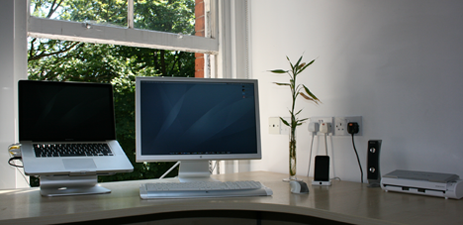
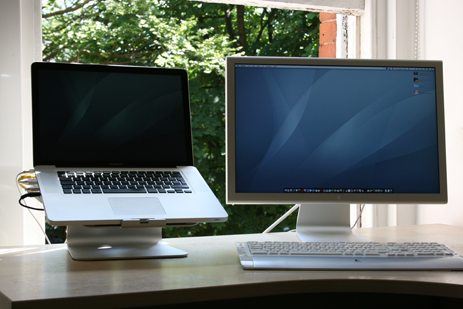
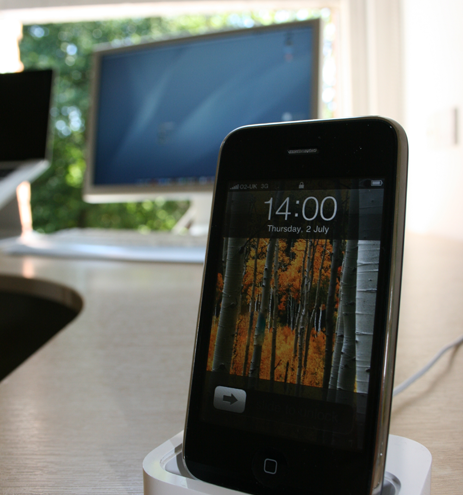
2. What is your current Mac setup?
A 2.66GHz Intel Core 2 Duo MacBook Pro, with 4GB of RAM. It sits upon a Rain Design mStand which, whilst not the most versatile laptop stand, looks stunning.
I use a 23″ Apple Cinema Display as my primary monitor, along with a Logitech S530 Laser keyboard and mouse. I still rely on a 6 year old set of Altec Lansing 2100 speakers that work flawlessly.
In recent months I have come to love my ScanSnap S300M, a tiny duplex scanner capable of providing a completely paper-free office environment.
3. Why are you using this setup?
I have found that portable Macs offer all the power I require in a far more useful form factor than a desktop. Since purchasing a first generation MacBook I haven’t looked back. Coupling my notebook with a large monitor feels natural and works wonders for productivity.
The original reason I made the move to OS X was for the wonderful user interface. It shunned the brash colours of Windows and appealed to the designer in me. After a few months I began to fall in love with all the other benefits of the platform.
4. What software do you use on a daily basis, and for what do you use it?
I use all of the following on a very regular basis:
- Mail – I remain reluctant of moving to a web-based system, and enjoy the simplicity offered by Mail.
- Safari – One of the reasons I originally switched to OS X, and still the fastest browser available for the platform.
- Things – For organizing my life and scheduling tasks to remember in the future. A fantastic user interface.
- NetNewsWire – Great iPhone synchronization makes this my go-to choice for RSS. I’m also experimenting with Fever.
- Tweetie – Having swapped between various Twitter clients, I’ve settled on Tweetie for now.
- DevonThink Pro Office – For maintaining the aforementioned paperless office. It offers incredible OCR for scanned and imported PDF documents.
- Spotify – Being in one of the supported countries, I’m a huge fan of the free streaming music service on offer.
- Pixelmator – For remarkably fast image editing. Not as powerful as Photoshop, but I find myself using it far more often.
- iWork 09 – I completely stepped away from Microsoft Office earlier this year. Pages and Numbers are perfect for my needs.
- Transmit – Still my FTP client of choice, though I also use ExpanDrive from time to time.
- TextMate – For coding and basic text editing.
- Querious – Makes working with MySQL databases enjoyable — no mean feat!
5. Do you own any other Mac gear?
I own a 1TB Time Capsule to act as a router and external hard drive for media, along with a 1TB Lacie d2 that mirrors my Time Capsule once a week.
An original MacBook (black) serves as a second machine if my MacBook Pro ever encounters a technical problem or surreptitious burglar.
I also own a few iPhones/iPods:
- A 16GB iPhone 3G, with me at all times.
- An 8GB iPhone now commandeered by my significant other.
- A 3rd generation iPod shuffle for running. Rarely used.
An Apple TV sits in my lounge, though slightly sub-par WiFi reception makes it somewhat of a hassle to use regularly. Plans are in place to run an ethernet cable, but it’s no easy task.
6. Do you have any future upgrades planned?
I’m thoroughly content with my current Mac setup, though would likely purchase a 30″ LED Cinema Display if Apple ever get around to producing one. I’m also a big fan of the MacBook Pro keyboard, and will pick up a Wireless Apple Keyboard to replace my Logitech at some point in the near future.
More Sweet Setups
David’s setup is just one in a series of Sweet Mac Setups.
Linear Drum Beats →
Lukas Mathis’ article on modes versus quasimodes yesterday reminds me of linear beats versus layered beats on the drums. Linear beats are when you only play one sound surface on the drums at a time. Versus a layered beat, where you play multiple sound surfaces at the same time.
(If the lesson video linked to above isn’t that exciting, and you just want to see some crazy drumming, check out these clips of Mike Portnoy from Dream Theater. Mike often played face-melting linear drum beats and fills.)
Ticket to Ride →
Speaking of birthdays, this was one of the first gifts I got today. It’s a very fun and well-made board game for the whole family. And if you too are in the giving spirit, pick up Ticket to Ride via this Amazon affiliate link, and send little extra birthday cash my way.
Reader Setup: Kevin Rodgers
Kicking off the first of the reader’s setups is Kevin Rodgers. Kevin is a Senior Systems Engineer for a K-12 public school district in New Jersey. Computers are his forté.
Kevin’s Setup:
1. What does your setup look like?
Home:
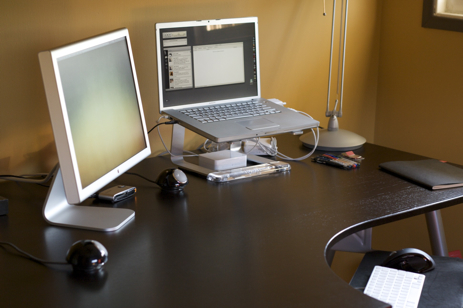
Work:
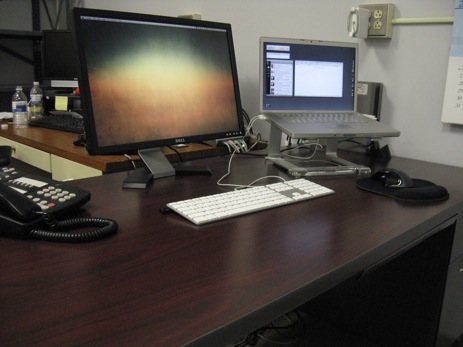
2. What is your current Mac setup?
A 15″ 2.16 GHz Intel Core 2 Duo MacBook Pro with 2 GB of RAM that I purchased in March 2007. I use it at home and at work.
At home, I connect to a 20″ Apple Cinema Display (ACD), a LaCie 250 GB External FireWire drive, and JBL Spot speakers. The external display at work is a 22″ Dell E228WFP that has the same resolution as the ACD.
In each location, I have an Apple wired keyboard, a Logitech MX Revolution mouse, and a Griffin Elevator desktop stand. A pair of Sony MDR-EX85LP headphones drown out the ambient noises at the office and help me focus on my work.
3. Why are you using this setup?
OS X is the finest operating system I’ve ever used, and the MacBook Pro is powerful enough for everything I need to do. Using the same computer for both home and work means I only have to buy one copy of the applications I use and also negates synchronization problems. I’ve read how people attempt to keep multiple computers in synch, but for me this is a non-issue.
With the laptop situated to the right of an external display, I run all my communication apps on the MacBook Pro’s screen. It’s far enough to the side to not be distracting and close enough for glancing at new items.
4. What software do you use on a daily basis, and for what do you use it?
- OS X Mail: I have three email accounts setup: one Mobile Me and two Gmail.
- Microsoft Entourage 2008: I currently use Entourage to connect to our Exchange Server, but will move to OS X Mail on Snow Leopard when it comes out. I’ve tried using Leopard’s Mail for sending and receiving messages, but things got tricky with meeting requests, so I went back to Entourage.
- iCal: I have Entourage synching with iCal so all my work and personal appointments are available. I also use it to track when my bills are due.
- Adium: I like Adium for instant messaging primarily for the border-less window appearance.
- 1Password: Working in the IT field means I have a lot passwords to track (currently over 130). For a while, I was storing them in Yojimbo, but the amount of steps required to access them was slowing me down. 1Password takes care of that with its browser integration and one-click copy button.
- Terminal: I use the Terminal quite a bit for network troubleshooting. Ping, dig, host, and traceroute are some of the most often used utilities. I also use it to connect to network devices and servers over SSH. The display is currently set to 13 pt. white Anonymous Pro (no antialias) on a black background.
- Things: By far, my favorite application for keeping track of all my work and home projects and tasks.
- Yojimbo: This is where I store software serial numbers and license codes, bookmarks for KB articles, quotes from vendors, and web receipts. After I purchase something online, I use the Save PDF to Yojimbo feature to save the confirmation page.
- TextExpander: I use this for expanding email signatures, some canned email responses, and a few Terminal commands. So far, it has saved me from typing over 200,000 characters.
- Google Quick Search Box: For application launching, queuing iTunes music, and showing contact phone numbers in large type.
- SuperDuper!: I let Time Machine handle regular backups and supplement it with full HD clones from SuperDuper! On average, I remember to execute the backup about 3-4 times a week. OK, more like 2-3 times a week.
- Remote Desktop Connection Client 2: Part of my job is working with Windows Servers. The RDC client works perfectly for connecting to them.
5. Do you own any other Mac gear?
I have an 802.11g Airport Express and four iPods:
- 1st generation blue 4GB iPod mini: For the iHome alarm clock
- 40GB iPod photo (also known as iPod with color display): For the car
- 2nd generation silver 1GB iPod Shuffle: For working out
- 1st generation 8GB iPod Touch: For the apps
6. Do you have any future upgrades planned?
I’ve had me eye on an Apple TV and might pick one up soon. I’ll probably buy it from Apple’s Refurbished items store. You get the same product with the same warranty at a cheaper price. Plus, all refurbished products are tested and certified by Apple. Something which cannot be stated for the brand new ones.
More Sweet Setups
Kevin’s setup is just one in a series of Sweet Mac Setups.
Is Texting While Driving More Dangerous Than Driving Drunk? →
Car and Driver Magazine finds out what we all could have guessed anyway. (Via @ianbarker)